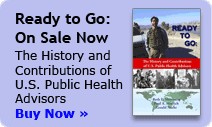Task Force 2010 Report
Appendix C
SUMMARY OF RECOMMENDATIONS
Purpose
Ø The Task Force recommends that the Executive Committee retain the
name, The Watsonian Society, An Organization for Public Health
Advisors.
Ø The Task Force recommends that the
Executive Committee revise the purpose and objectives to create a mission statement to better define and
sustain the organization.
ØThe Task Force recommends that the
Executive Committee develop a biographical sketch of Mr. William E.
(Bill) Watson Jr., and include it in the appropriate section of
Society's Constitution or Bylaws.
ØThe Task Force recommends that the
Executive Committee consider expanding membership eligibility to
include past and present CDC/ATSDR employees with work experience
similar to that of "traditional" PHAs.
Ø The Task Force recommends that the
Executive Committee consider creating a position of Executive
Director.
Financial Positioning
Ø The Task Force recommends that the Executive Committee consider
increasing dues if necessary to support an Executive Director
position.
Ø The Task Force recommends that the
Executive Committee consider developing an additional option for all
members to purchase a lifetime membership.
Ø The Task Force recommends that the
Executive Committee consider fund raising activities be limited to
specific projects.
Member Services and Personal Growth Opportunities
Ø The Task Force recommends that the Executive Committee significantly
improve communication with members, particularly with the field
staff.
Ø The
Task Force recommends that the Executive Committee develop and
maintain a Watsonian Society web site.
Organizational Growth Opportunities
Ø The Task Force recommends that the Executive Committee's immediate
focus be placed on increasing membership from CDC employees in the
685 series who are currently not members of the Watsonian Society.
Ø The Task Force recommends that the Executive Committee establish a
recruitment- membership committee, and consider two subcommittees,
one for field staff and a second for headquarters staff.
Ø The Task Force recommends that the Executive Committee consider
expanding recruitment of non-PHA's as a long-term growth strategy
but offer full membership to those meeting certain qualifications.
Ø The
Task Force recommends that the Executive Committee consider further
study regarding an "affiliation agreement" with the
Federal Managers Association (FMA).
Ø The Task Force recommends that the Executive Committee consider
exploring the development of partnerships, alliances and
collaborations specific to special initiatives and activities of
mutual concern with CDC-supported and other organizations.
Ø The Task Force recommends that the Executive Committee not consider
consolidation with any other organization, or any other scenario
that would result in the Watsonian Society losing it's unique
identity or organizational independence.
Appendix
D
Member Survey Instrument(an Adobe pdf document)
Appendix
E
Organizational Distribution of Survey Participants
(an Adobe pdf document)
Appendix F
Watsonian Society Member Survey
Ranked by Weighted Importance
Q1.1 serve and represent the interests and concerns of Public Health Advisors (PHAs) and public health in general. (21)*
Q4.3 advocate hiring of PHAs in private sector health programs and inform members of professional employment opportunities with voluntary organizations. (17)
Q4.2 provide career counseling to members, such as long-term career planning advise and resume writing. (8)
Q4.1 expand opportunities to access the Society's mentor services for members regarding KSAs /training to enhance career development opportunities. (13)
Q5.5 establish an
"affiliation agreement" with another management-related
organization,
(i.e., Federal Managers Association). (7)
Q5.3 actively recruit into WS membership non-permanent CDC staff (e.g., Public Health Prevention Specialists) whose assignments are often comparable to PHAs. (9)
Q5.4 explore affiliation opportunities with other CDC-supported organizations, such as the Council of State and Territorial Epidemiologist (CSTE). (3)
Q2.1 identify new and expanded opportunities for field staff to become involved and participate in community service activities. (12)
Q5.1 provide organizing support for new local, geographic-based (e.g., New York City, Chicago) WS chapters. (11)
Q3.2 identify new funding mechanisms, in addition to membership dues, to support Society member services. (11)
Q3.4 identify and partner with another CDC-sponsored organization to expand our member and financial base. (7)
Q3.5 retain the services of a paid Executive Director to coordinate fund raising and member services. (3)
Q2.5 develop an Internet web site to improve communication of Executive Board meetings, newsletter, and member events. (9)
Q2.4 establish a new member service to support PHAs who are transferred by identifying a local "ombudsman" to assist families with social/cultural transition. (6)
Q3.1 increase WS membership dues to expand member services. (6)
Q2.2 expand emphasis on family services activities to include a wider range of significant life events of members - professional as well as personal. (5)
Q3.3 develop an annual report to the membership that communicates how much dues were collected and how they were spent. (3)
Q1.4 actively encourage, support, and facilitate PHA promotion opportunities across all CIOs and programs. (2)
Q2.6 organize the WS annual banquet to allow all members to participate in the meeting portion via interactive technology, such as audio/video tele-conference. (3)
Q1.6 expand the purpose of the Society to include "recognize and enhance excellence in public health management." (2)
Q5.2 provide organizing support for new chapters specifically for retirees. (0)
Q1.7 engage in activities that will strengthen the image and perceptions of the Society and members among CDC senior managers and other organizations. (4)
Q2.3 increase number and types of social events (e.g., golf tournaments, retirement celebrations) providing opportunities for informal networking among members. (0)
Q1.5 be an advocate and pro-active supporter of PHAs in personnel management/administrative-related issues, where appropriate. (2)
Q1.2 remain an independent, self-governed CDC-sponsored employee organization. (1)
Q1.3 restrict full membership to those whose work history (i.e., state and/or local assignments) reflects those of the PHA / 685 series. (0)
* denotes the number of
respondents rating this issue "#1" or most important in
the Section
(N = 35, Member survey response rate 35.4%)
Page last updated February 6, 2011
The contents of the Web site or communication of employee association information through other government resources does not constitute or imply endorsement of the operations and activities of the association by CDC or the U.S. Department of Health and Human Services.

